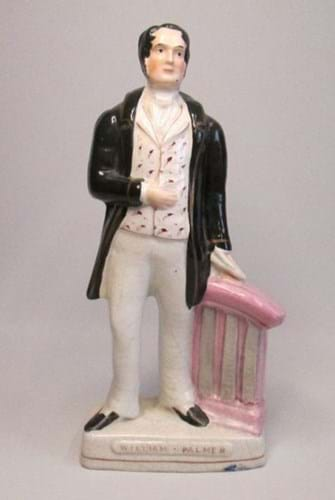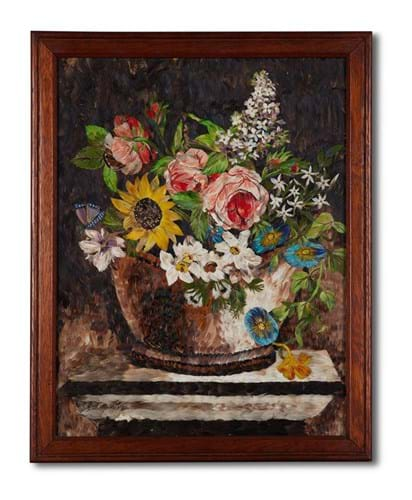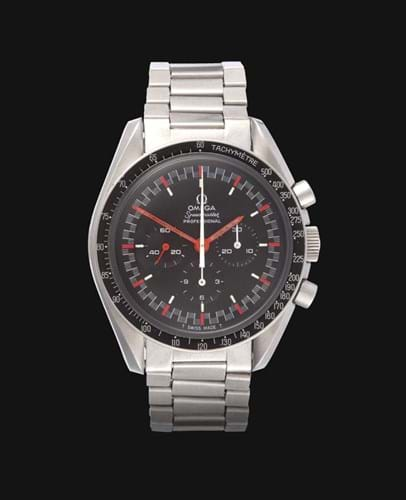1. Oscar Nemon clay maquette of Sir Winston Churchill – £4000
The Anglo-Croatian sculptor Oscar Nemon (1906-85) first met Sir Winston Churchill when holidaying in Marrakech in 1951. Nemon was Churchill's choice of sculptor when Elizabeth II commissioned a bust of Sir Winston for Windsor Castle in 1952 and he would go on to create more than a dozen public statues of the wartime Prime Minister including the 1970 bronze that stands in the Members Lobby of the House of Commons.
This small clay maquette (above), 10in (25cm) high signed Nemon, came for sale at Semley Auctions in Shaftesbury on November 13 as part of ‘the property of a lady of title’. It relates closely to the figure of Churchill that appears in Married Love, the sculpture at Westerham Green, near Chartwell, which features the statesman in a similar seated pose alongside his wife Clementine. She later commented: 'That is how I see him and that is how I love him'.
Previous auction results for Nemon-Churchill bronze and resin casts suggested the estimate of £200-300 for this maquette was little lightweight. So it proved when it took £4000.
2. Watercolour of John Ruskin in the Lake District – £3200

William Gershom Collingwood watercolour of John Ruskin in his study at Brantwood – £3200 at Bainbridge’s.
This watercolour by William Gershom Collingwood (1854-1932) depicts Brantwood, the Lake District home to the art and social critic John Ruskin (1819-1900). The two men had met at Oxford in 1872 and for many years Collingwood, author, artist and antiquary, dedicating himself to helping Ruskin, staying at Brantwood as his assistant and travelling with him to Switzerland.
When he married in 1883, Collingwood too settled in Coniston where, as President of the Cumberland and Westmorland Antiquarian Society and the Lake Artists' Society, he edited a number of Ruskin's texts, published his biography in 1893 and latterly founded the Ruskin Museum in 1901.
Close inspection of this 8 x 10in (20 x 25cm) painting shows Ruskin in the turret window of his study at Brantwood. It appears to have been a gift from Collingwood to Dr John Kendall of Coniston, a friend and personal physician to Ruskin.
Offered for sale by one of Kendall’s descendants at Bainbridge’s in West Ruislip on November 11, it was estimated at £200-250 but took £3200.
3. Staffordshire portrait figure – £1900
A vast cast of popular and contemporary characters in ceramic form, Staffordshire portrait figures were a phenomenon of the Victorian era. Catering to popular demand, the royal family and military heroes were by far the most common subjects for these cheap and cheerful pottery groups but topicality was everything.
Most curious to today’s eyes was the appeal of figures of notorious criminals of the period. The most desirable figure in the Dennis Silk collection of 261 Staffordshire portrait figures sold at Hansons at Bishton Hall, Staffordshire on November 12, was one of these.
William Palmer (1824-56), also known as the Rugeley Poisoner or the Prince of Poisoners, was an English doctor found guilty of murdering his friend using strychnine in one of the most notorious cases of the 19th century. Charles Dickens called Palmer – also suspected of poisoning his wife, brother, mother-in-law and four infant children – "the greatest villain that ever stood in the Old Bailey”.
Estimated at £700-1000, this was comfortably the top lot of the sale selling at £1900.
4. 18th century feather collages – £6500
This 18th century collage of a basket of flowers is one of a pair made entirely from painted feathers. Today they are rare survivors but it seems the craft was popular in the 18th century as both a winter pastime for ladies and a professional undertaking.
The best known name in feather work is the French-born Nicholas Le Normand (d. 1736) who operated from a workshop in Putney. He is described in 1732 as 'the ingenious Mr Le Normond' [sic], who sold his featherwork pictures through a number of Georgian luxury ‘toy’ stores including Mr Bertrand's Toyshop at Terrace Walk in Bath and the Charing Cross shop of Paul Daniel Chenevix.
The fashion for featherwork continued into the late Georgian period. As detailed in a Country Life magazine article in January 1976 these panels, each measuring 20.5 x 153/4in (52 x 40cm) in mahogany frames, were created by Susanna Jennens (1688-1760) for Weston Hall, Northamptonshire, the home over two centuries.
Included in Dreweatts sale titled Weston Hall and the Sitwells: A Family Legacy on November 16-17, they were estimated at £400-600 but sold at £6500.
5. Omega Speedmaster – £85,000
Sold for a double-estimate £85,000 at Tennants in Leyburn on November 13 was this Omega ‘Red Racing’ Professional Speedmaster (ref 145012). There are numerous variants of the 1960s Speedy – all of them hugely collectable – but few are better than those with the exotic ‘Red Racing’ dial.
They were only produced by Omega in 1967-68, in two generations and three different executions. This watch, the second variant, had been in the same family since it was purchased from Bagshaws of Liverpool in 1970 and was sold with original paperwork. It is one of only half a dozen to come to market, although another sold at Sotheby’s New York in February for $75,000. That example had the name Meister to the dial – the Zurich based retailer where the consignor Henk de Vries had bought it in 1969.
De Vries, a Dutch-Canadian adventurer who wore his trusty Speedmaster when crossing the Andes and sailing the Atlantic Ocean.









